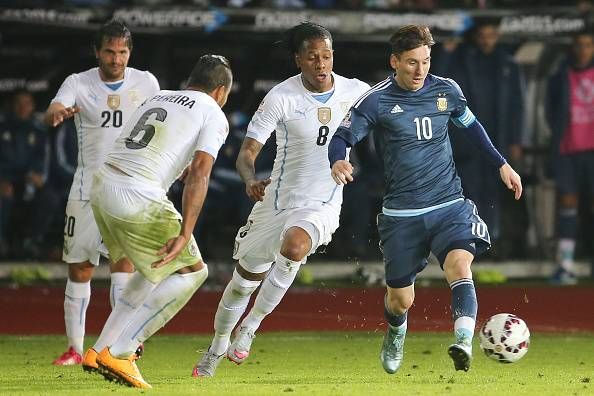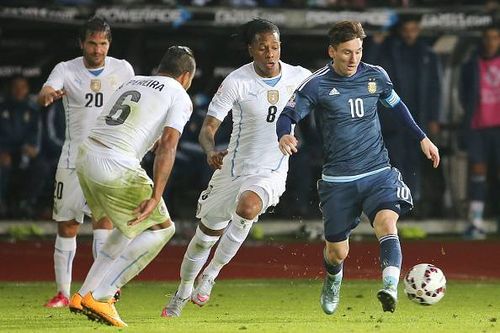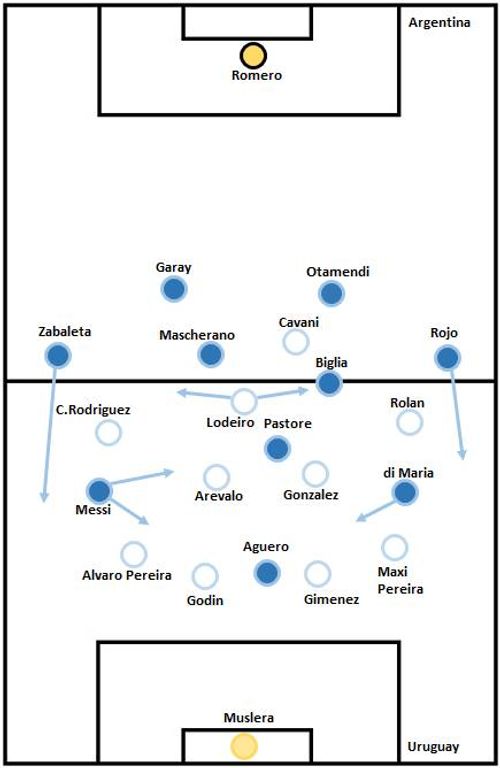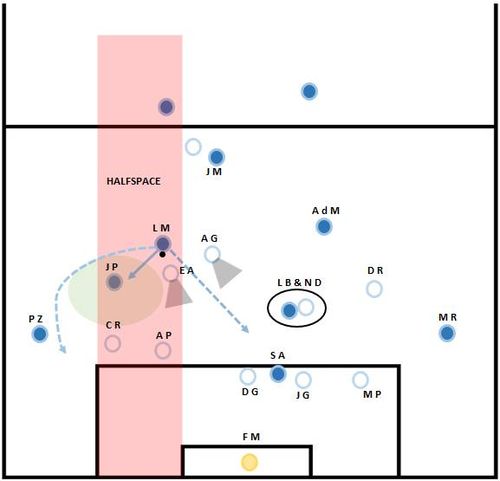
Copa America 2015: Tactical analysis of Argentina's 1-0 win over Uruguay

Gerardo Martino, after watching his side surrender a lead of two goals to Paraguay, brought back Lucas Biglia and Pablo Zabaleta, the two regulars at the World Cup of last summer, into the starting eleven at the expense of Ever Banega and Facundo Roncaglia. He continued with the same set of attacking players from the last match – Sergio Aguero, Lionel Messi, Angel di Maria and Javier Pastore.
Oscar Tabarez made one change by starting Alvaro Gonzalez in the midfield in place of Carlos Sanchez. The rest of the team remained same.

Uruguay start defensively:
Since Uruguay won their first game of the Copa, Tabarez just needed his team not to lose to Argentina in order to strengthen their chances of qualifying to the knockout round.
In the game against Jamaica, he fielded a 4-4-2 formation with Diego Rolan starting alongside Edinson Cavani upfront. In this match, Rolan was moved wide towards the right. Nicholas Lodeiro played behind Cavani in a formation which looked like a 4-2-3-1 in the initial stages of the match.
With wingers Cristian Rodriguez and Rolan falling back during the defensive phases, Tabarez intentions became clear. The team was playing a 4-4-2 system and Lodeiro’s presence offered more flexibility as he acted like a connector to the team during attacks.
Aware of the attacking potential of Argentina and the threat posed by its forwards, Tabarez asked the defensive line and midfield lines to offer no space for the forwards of the opposition to sneak into.
High press:
In the early stages of the match and as the match neared its end, Uruguay displayed their ability to press high up the pitch. Alvaro Gonzalez and Egidio Arevalo are both defensive midfielders by trade and their pairing in the midfield allowed Lodeiro, Cavani, Rolan and Rodriguez to counter press very high up the pitch.
It somewhat proved to be successful as Uruguay were winning a lot of second balls. Rolan’s missed chance in the 75th minute and Gonzalez’s shot from outside the box in the 79th minute were results of the pressing done by the Tabarez’s men near Argentina’s box.
Argentina’s attack:
The most talked and most awaited aspect of the game was: Will Argentina’s attackers finally shine in a major tournament? Because in the previous World Cup, Argentina relied heavily on Lionel Messi and never seemed like a unit. Although Sergio Aguero and Leo Messi scored in Argentina’s opening game against Paraguay, the attackers were not up to the mark.
The 4-3-3 system used by Martino against Paraguay was carried over to this game also. Angel di Maria and Messi drifted into the middle whenever and wherever opportunities were presented to them. This forced the wingbacks Alvaro Pereira and Maxi Periera to stay narrow and deep – they never made any real and lasting impact during their own attacks, except a shot by Maxi in the second half.
The involvement of Argentina’s wide forwards in midfield also forced Rodriguez and Rolan to abandon their wide positions. This resulted in huge amounts of free space on the flanks for Pablo Zabaleta and Marcos Rojo to move forward, explore, and exploit.
Since Javier Mascherano was dropping deep to soak the pressure and provide passing options for the central defenders, Nicolas Otamendi and Ezequiel Garay, during the build-ups of attacks Argentina’s line-up resembled a 3-6-1 system – Rojo and Zabaleta as the wide midfielders; Lucas Biglia and Javier Pastore moving out into wider positions; and Messi and di Maria in narrow positions.
As the other attacking midfielders provided great fluidity, Biglia and Mascherano reinforced the midfield. As expected Argentina enjoyed a major share of possession. But due to the resilience of Uruguay’s defenders, the Albiceleste were not allowed to create many clear-cut opportunities and the ball was frequently played out to the wings.
Messi – Pastore:
There were a few occasions where the brilliance of Messi and Pastore proved very much helpful for Argentina. One such scene is explained below, and this resulted in the only game of the goal.
Messi was always drifting inwards in search of space. The presence of Zabaleta on the wings in an advanced position allowed him to move towards the central zone of the field.
Also, he exchanged positions with Pastore a good number of times which in turn allowed him to move into the heart of the midfield. We have seen Messi change positions with Ivan Rakitic this season for FC Barcelona. Rakitic used to fill the gap left by Messi and confuse the opponents near him. He was also very good at linking Messi and Dani Alves. A similar task was carried out by Pastore and it resulted in Aguero’s goal.

Argentina’s defence and set-piece vulnerability:
Paraguay exposed the main flaw in Argentina’s system – their defence. Against Uruguay, it was the presence of Biglia that proved to be the difference. The Argentine was either winning the ball back or intercepting the passes in Uruguay’s half and helping stop counter-attacking moves at the early stages.
However, Argentina’s vulnerability in defending the set-pieces raised up once again. Of the 23 aerial duels won, Uruguay managed to win eight (36%) inside Argentina’s 18-yard box. The fact that none resulted in a goal is a shocking thing.
Whenever Mascherano dropped to aid the two central defenders, Biglia and Pastore were left alone to parole the space in front of them. This resulted in a five shots from outside of the box.
Argentina need a strategy to close down this space. Uruguay were poor during their attacks – at a point, it seemed as if Uruguay lacked a good No.10 who could send defence piercing passes by using the space in front of the defenders.
Conclusion:
It was an unconvincing win for Argentina. For all the attacking players in the squad, it was really a dull result. Martino should devise a good strategy to keep the ball in the central zone for longer periods of time.
As for Uruguay, the forwards are not finding it easy to score and keep things interesting. One positive thing for Uruguay is that they have managed to lose by a margin of just one goal against Argentina, the team with the deadliest attacking force.
This article has been contributed by a member of the SK Featured Bloggers Club. It was originally published on the ‘Early Shower’ blog here.